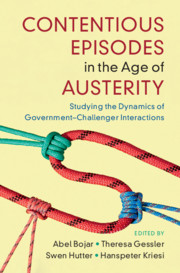 Contentious Episodes in the Age of Austerity
Contentious Episodes in the Age of Austerity Book contents
- Contentious Episodes in the Age of Austerity
- Cambridge Studies in Contentious Politics
- Contentious Episodes in the Age of Austerity
- Copyright page
- Contents
- Figures
- Tables
- Contributors
- Preface
- Part I A New Approach to the Analysis of Contentious Episodes
- Part II Varieties of Contention
- Part III Dynamics of Interaction
- 8 Interaction Dynamics in Contentious Episodes: Path-Dependence, Tit-for-Tat, and Constructive Mediation
- 9 The Governments’ Reactions to Challengers and Third Parties
- 10 The Effect of Repression on Protest
- 11 Turning Points
- 12 The Greek Case
- Part IV Conclusion
- Appendices
- References
- Index
- Series page
9 - The Governments’ Reactions to Challengers and Third Parties
from Part III - Dynamics of Interaction
Published online by Cambridge University Press: 05 November 2021
- Contentious Episodes in the Age of Austerity
- Cambridge Studies in Contentious Politics
- Contentious Episodes in the Age of Austerity
- Copyright page
- Contents
- Figures
- Tables
- Contributors
- Preface
- Part I A New Approach to the Analysis of Contentious Episodes
- Part II Varieties of Contention
- Part III Dynamics of Interaction
- 8 Interaction Dynamics in Contentious Episodes: Path-Dependence, Tit-for-Tat, and Constructive Mediation
- 9 The Governments’ Reactions to Challengers and Third Parties
- 10 The Effect of Repression on Protest
- 11 Turning Points
- 12 The Greek Case
- Part IV Conclusion
- Appendices
- References
- Index
- Series page
Summary
In the previous chapter, we have looked at the interactions between the three types of protagonists, independently of the context in which they interact. In the present chapter, we shall take context characteristics into account in order to identify the extent to which interaction dynamics are context-specific. In doing so, we shall focus on governments and analyze how their reactions to challenger and third-party actions depend on the context. The next chapter will change the perspective and analyze challengers’ reactions to government and third-party actions. In focusing on the governments’ reactions, we shall build on the analysis of the previous chapter. Concerning the governments’ reactions to challengers, the results found in the previous chapter were quite inconclusive. By and large, government behavior appeared to be independent of previous challenger actions, although the results to some extent supported the threat hypothesis with respect to repression. As far as the impact of third parties is concerned, we found some support for the isolation hypothesis: Governments had a higher propensity to repress challengers when they were not supported by third parties. The most important result, however, was the effectiveness of third-party mediation: Governments tended to honor mediation attempts with concessions. In the present chapter, we shall put these somewhat inconclusive results into perspective by taking into account the context-dependence of the governments’ reactions. In terms of mechanisms, we introduced environmental mechanisms that condition the relational mechanisms that we studied in a “context-blind” approach in the previous chapter.
- Type
- Chapter
- Information
- Contentious Episodes in the Age of AusterityStudying the Dynamics of Government–Challenger Interactions, pp. 166 - 189Publisher: Cambridge University PressPrint publication year: 2021
